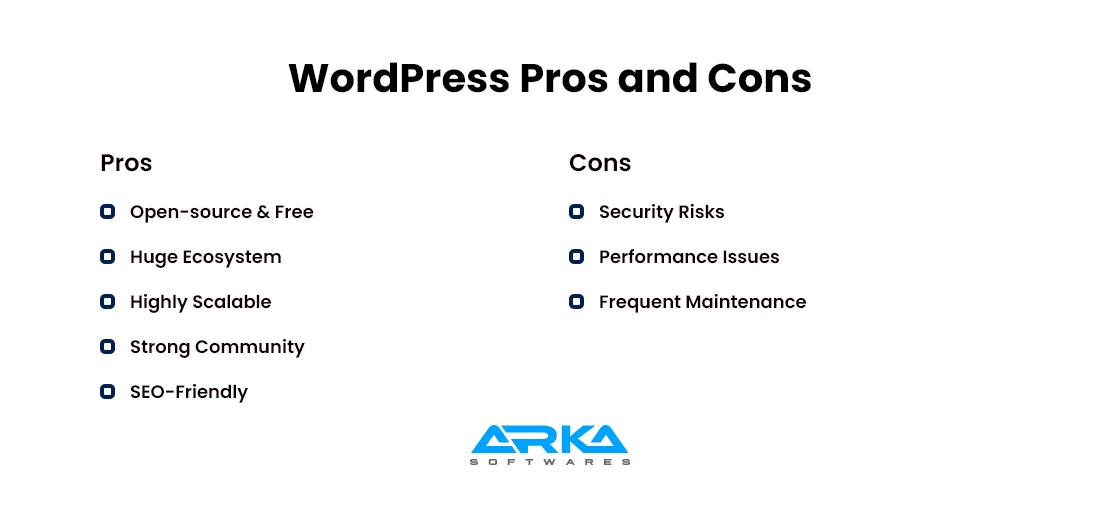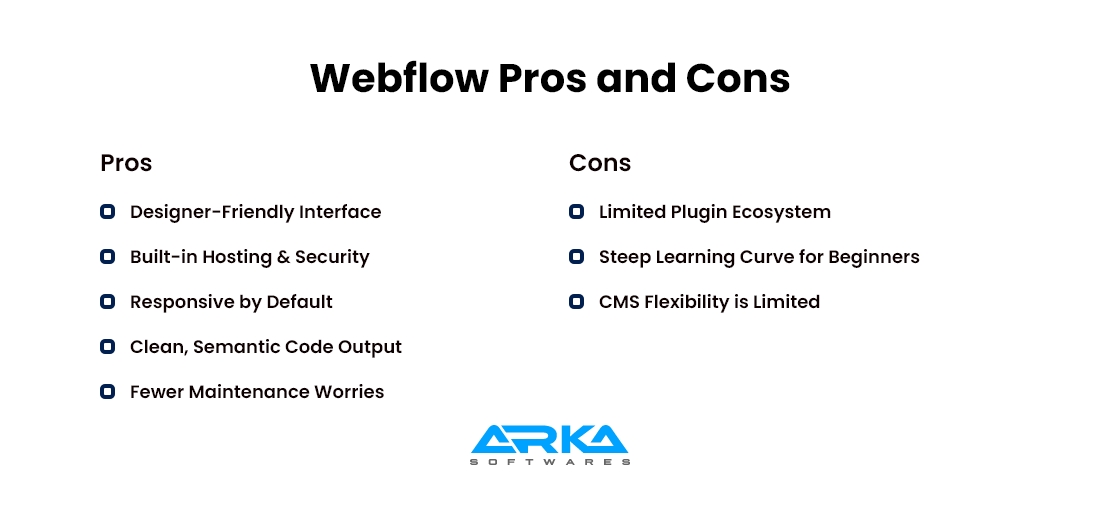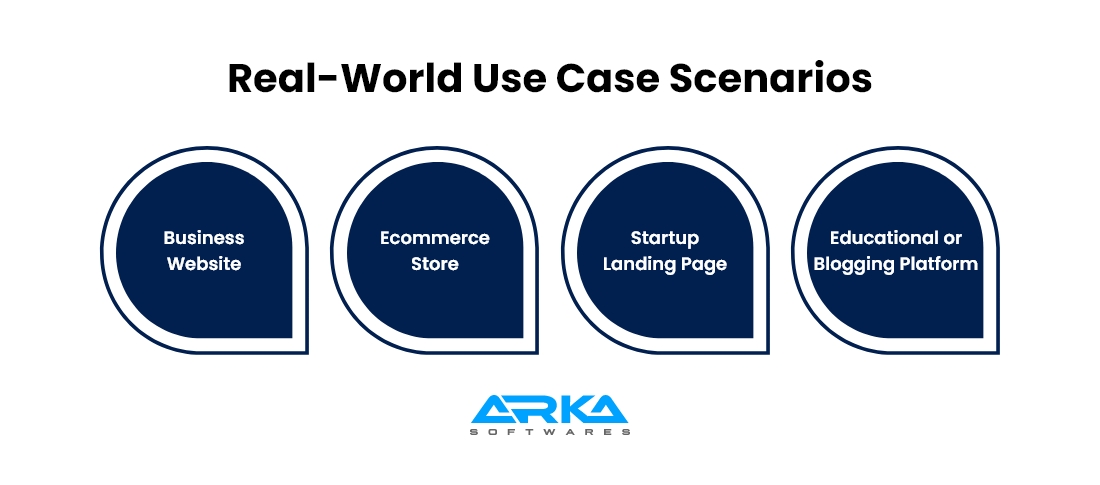This blog is a comparison of Webflow vs WordPress, where it talks about their pros, cons, features, SEO capabilities, design flexibility, pricing and use cases. WordPress excels in customization, plugins and content management, whereas Webflow is better in terms of design control, performance, and simplicity. As a developer, designer, or business owner, this guide will allow you to confidently choose Webflow vs WordPress as per your needs in 2025 and beyond.
The global web development market in 2025 is estimated to be worth $80.6 billion and will grow to $125.4 billion by 2030 with a CAGR of 9.3%. One of the most popular questions when creating a site is whether to use Webflow or WordPress. Both platforms have robust design, content management and performance tools, so it is not always clear which one to choose. The decision you make can influence everything: the appearance and functionality of your site, its maintenance, and the possibility of its growth.
This blog will discuss the major distinctions between Webflow vs WordPress, and will assist you in determining the best platform to achieve your objectives.
The Webflow vs WordPress debate revolves around two vastly different ways of creating websites. WordPress is an open-source, self-hosted CMS that powers more than 40% of the web. It is famous for flexibility, a wide range of plugins, robust blogging and Search Engine Optimization (SEO) features. It has a modular architecture and a wide community support that is enjoyed by the developers and the content creators alike.
Webflow, however, is a contemporary, cloud-based website builder that brings design, CMS flexibility, and hosting all together under one roof. It is visual-oriented and gives users the ability to create high-end responsive websites without any code. It has fewer dependencies and built-in features, the reason why it suits the needs of designers, freelancers, and businesses that require speed, aesthetics, and simplified site management.
In a Webflow vs WordPress comparison, the ideal option is determined by whether you want full control over the backend or a smooth design-first workflow.
Being the most popular CMS around the world, WordPress provides unmatched flexibility and an extensive ecosystem. But along with great power comes complexity. Below are the key WordPress pros and cons you should bear in mind before deciding to use WordPress for your next project.
Pros
Cons

Before settling on Webflow as your preferred site builder, it is important to understand the Webflow pros and cons. Although it features state-of-the-art design and has a workflow that is all-inclusive, it is not appropriate for all project types.
Pros
Cons

WordPress does not provide hosting. This gives you the flexibility to select a provider based on budget, performance and scalability. However, this flexibility implies that you will have to configure performance tools, install SSL certificates, take care of uptime and server security.
Webflow, on the other hand, provides fully managed hosting on the Amazon Web Services (AWS) platform with integrated SSL, CDN, backups and auto-scaling. This does away with the technical overhead of third-party hosting and is fast, reliable, and secure by default. Considering Webflow vs WordPress for developers, the all-in-one configuration of Webflow can be more attractive due to its ease of use and straightforward implementation.
WordPress has an enormous ecosystem of more than 55,000 plugins. You can append just about anything to it, such as forms, analytics, more complicated eCommerce or learning management systems. This flexibility enables you to develop extremely useful websites, which are relevant to your specific requirements. Nonetheless, plugins usually come with version incompatibilities, security vulnerabilities, and also have to be frequently updated.
Webflow is minimalist in terms of native functionalities. When you need more functionality, you can embed any external tools such as Zapier, Memberstack, or Airtable in custom embeds or via APIs. Although it does not have a large-scale plugin marketplace, this makes websites leaner, faster, and with less compatibility problems. If you’re trying to choose Webflow vs WordPress based on ease of maintenance and performance, Webflow might be the better long-term solution.
WordPress security is mostly dependent on the user. This is determined by the security of your hosting, the frequency of updating themes and plugins, and the use of measures such as firewalls or malware scanners. Web development security tips should be followed to ensure that your site is not at risk of attacks and exploitation.
Webflow manages security on the platform level. Each of the sites will have free SSL certificates, DDoS protection, and platform-wide updates. It is a closed system, so there is little chance of outside code or plugin-based hacks. Webflow has integrated security, which is a significant advantage to users seeking peace of mind and less maintenance.
WordPress is very simple to use on the surface level, particularly with a visual builder and pre-made themes. Yet, the more you need, the more you have to learn about the architecture of WordPress, such as templates, loops, custom post types, and management of plugins, which has a technical learning curve. Sophisticated customization would usually include PHP, HTML, and JavaScript.
Webflow has a narrower learning curve that is based on design values and layouts. To get the best out of it, it is important to understand the box model, flexbox, and grid systems. In a website builder comparison, Webflow has a quicker, easier-to-learn interface to create complex, responsive websites without code.
WordPress provides e-commerce with the help of WooCommerce, a flexible and powerful plug-in that is compatible with thousands of themes and add-ons. It provides complete control of checkout pages, products type, shipping, and payments. It is perfect to use in stores that have complicated requirements, as it is highly customizable using custom code, extensions, and integrations with popular tools such as Stripe, PayPal, and Square.
The ecommerce development solution provided by Webflow is an integrated part of the platform that functions in conjunction with the design interface. And you can completely customize product pages, cart and checkout flows without writing any code. Nevertheless, it has fewer third-party payment gateways and extensions than WooCommerce.
The performance of WordPress is very much related to the quality of hosting, the number of plugins, and the theme optimization. Although caching plugins such as WP Rocket and CDNs like Cloudflare can give you great page speeds, you will need to monitor performance constantly. When not taken care of, the slow loading speed may adversely affect both SEO and user experience (on mobile).
Webflow, however, is optimized right out of the box. Sites are deployed on high-performance, world-wide distributed servers that come with CDN capabilities. Webflow also minifies the code, compresses the images, and automatically controls caching. When you compare Webflow and WordPress, Webflow is an optimized, clean alternative that demands much less manual adjustment.
WordPress allows a team-based workflow, with user roles such as Admin, Editor, and Author, and can be helpful on a site with a lot of content or a large blog. But editing in real-time is not great and in many cases, teams may operate with third-party tools or staging environments to handle content workflows, revisions, or client approvals.
Webflow has strong collaboration tools, which can be found in its Editor and Team plans. Clients and content managers will be able to edit text and images on the actual site without having to go into the complicated design interface. Also, Webflow provides version control, staging environments, and real-time feedback tools that optimize collaboration among designers, developers, and content teams in a single ecosystem.

In the case of SEO, Webflow vs WordPress are powerful in their own unique ways. Plugins such as Yoast SEO, Rank Math, and All in One SEO Pack have made WordPress a long-time favorite. The tools offer capabilities such as meta tag management, content readability, XML sitemap creation, schema markup and more. WordPress can also be highly customized using .htaccess, robots.txt, and third-party add-ons to include analytics and tracking.
Webflow, however, incorporates much of this SEO functionality into the platform. You will be able to edit meta titles and descriptions, set alt text, add structured data manually and create 301 redirects, without needing to use any plugins. Businesses who want an efficient and simplified SEO experience, without having to maintain and manage the plugins themselves, the best solution is Webflow coupled with professional web development services. This makes the site not only visually stunning but also highly ranked on search engines.
One of the most significant aspects of the Webflow vs WordPress discussion is design flexibility. WordPress uses themes and drag-and-drop page builders, such as Elementor, WPbakery, or Divi, traditionally based on the use of plugins. These tools allow non-coders to design layouts, although they may cause bloated code, impact the speed of the site, and in some cases, lack the ability to create precision at the pixel level. To perform deep customization, you may have to edit theme files or custom CSS and JavaScript.
In contrast, Webflow has a complete visual design interface. The Webflow visual editor can be used to create complex layouts and animations, as well as responsive designs, all within the browser, just like HTML and CSS. No third-party tools/templates are required unless you want them. This means that Webflow is the dream tool of any designer, providing complete creative freedom and clean code output.
In the comparison of Webflow or WordPress as a blogging platform, WordPress remains the king of the best blogging platforms to date. It has native blogging architecture that supports tags, categories, rss feeds, custom fields, and multi-author blogs. It works well with blogs, news websites and magazines because content scheduling, media management and editorial processes are smooth. And there are thousands of other plugins that can be used to add functionality, such as SEO tools, social sharing and content versioning.
Less experimental and more structured, yet design-oriented, Webflow is more powerful. Its CMS has a feature called “Collections” as a way to organize blog posts or other repeatable content. You have the option to visually style templates on each post type, but advanced blogging functionality such as content scheduling, commenting or RSS may need third-party tools or creative workarounds. It works great on design-oriented sites where blogging is only occasionally, but not the best choice when it comes to high-volume or editorially-focused content strategies.
With regards to community and support of WordPress vs Webflow 2025, WordPress boasts a huge global ecosystem. It is more than 20 years old and open-source, so it has thousands of tutorials, documentation, developer forums, YouTube channels, and third-party support services. Be it free advice or professional assistance, help is never far. Also, WordPress developers and agencies are easily available throughout the regions to create a professional business website UAE.
Webflow, though newer, has rapidly attracted a very dedicated user base. Its official “Webflow University” is among the best self-learning platforms with quality video tutorials and courses. The support is provided through email, forums, and community groups. Compared to the size of the WordPress ecosystem, Webflow is limited in the amount of resources they have to offer, but resources are more targeted specifically to designers and visual developers who need a modern workflow and fast problem-solving.
To further appreciate the practical advantages of Webflow vs WordPress for small business, we will look at use cases where each platform excels. One platform can be much more beneficial than the other, depending on the purpose of your website, the level of technical skills and the development objectives.
WordPress works perfectly with service-based companies that require SEO, lead capture forms, and appointment booking plugins. It is flexible and scalable in budget due to its plugin ecosystem.
Webflow is ideal when a small business needs a modern and professional appearance without dealing with plugins and hosting. The visual design tools enable you to build a sleek site without much technical work.
WordPress, powered by WooCommerce, is an excellent choice when it comes to stores that require extensive customizations, filtering, shipping requirements, and payment gateways. It is adaptable and can be used with complicated catalogs.
Webflow is suitable when you have a simple or boutique e-commerce shop that emphasizes appearance. It can have completely branded product pages and a smooth checkout experience with Stripe or PayPal.
WordPress can be quickly configured with a starter theme or a page builder, particularly, pre-designed templates focused on conversions. It is perfect when a business wants to test MVP or collect sign-ups.
Webflow provides startups with a custom design landing page that is optimized to perform well without development expenses. Visual tools make animations, scroll effects, and rapid prototyping possible.
WordPress is the default choice of content-centered websites, so it is ideal when creating blogging platforms and tutorials or online course platforms with a plugin such as LearnDash or Tutor LMS.
Webflow is good when the blog is more about design and architecture but not so good when it comes to more in-depth capabilities of blogging. Visual storytellers who have less complex publishing requirements should use it.

| Feature / Cost Item | WordPress | Webflow |
| Platform Cost | Free (open-source) | Paid plans only (no free plan for custom domains) |
| Hosting | $3 – $30/month (varies by provider & performance) | Included in all paid plans |
| Domain Name | $10 – $15/year | $10 – $15/year (third-party) |
| Themes/Templates | Free to $100+ (one-time) | Free to $80+ (one-time or included in templates) |
| Page Builder/Editor | Free (Gutenberg) or $49+/year (Elementor, etc.) | Included in all plans |
| Plugins/Add-ons | Free to $100+/year per plugin | Limited—most features built-in or via external tools |
| Maintenance & Security | Manual or via services ($0 – $300/year) | Included in hosting (automatic updates, SSL, backups) |
| E-commerce Functionality | Free with WooCommerce, plus add-ons ($0 – $200+/year) | Starts at $42/month (Standard plan) |
| Total Estimated Cost (Basic Site) | $60 – $300/year (self-managed) | $168 – $456/year |
| Total Estimated Cost (Advanced) | $500 – $1,500+/year (plugins, hosting, support) | $456 – $2,820/year (Business & E-commerce plans) |
When it comes to Webflow vs WordPress, the decision is based on your preferences: creative freedom, technical control, usability and cost. Neither of the two is superior; they cater to different users and business objectives.
You are looking to have full flexibility, superior content management, and access to thousands of plugins. WordPress is perfect for blogs, complex websites and businesses that need custom functionality or have the need for a multilingual setup. It has the best ecosystem and the talent to support or scale is easy to find. For content-rich, SEO-driven and plugin heavy sites, WordPress is still the better long-term solution.
You want visual design control, built-in performance, and hassle-free hosting. Webflow is ideal for any creative professional, agency and startup that wants a modern responsive site without writing code. It particularly fits portfolios, landing pages, and design-driven businesses. Assuming that you are interested in rapid growth, visual storytelling, and keeping the technical overhead low, Webflow will undoubtedly be the clear winner.
Choosing between WordPress vs Webflow 2025 can only be determined by what you want to achieve, the level of your expertise, and the project at hand. WordPress is highly flexible, has a huge ecosystem of plugins, and is highly customizable, which is why it is best suited for content-rich or complex websites. Webflow, on the other hand, offers a modern, minimal platform with visual design capabilities and hosting, and is ideal to use in case you are a designer, an agency, or a business focused on simplicity and clean design.
Ultimately, there is no universal solution. The most suitable option is the one that suits your vision, resources and the degree of control you prefer over design and functionality.
In the Webflow vs WordPress for small business debate, WordPress is more cost-effective, but Webflow’s maintenance-free approach is ideal for non-technical owners.
Yes, you can design in Webflow and export code to WordPress. However, you’ll lose Webflow’s CMS features, making this combination less practical for dynamic websites.